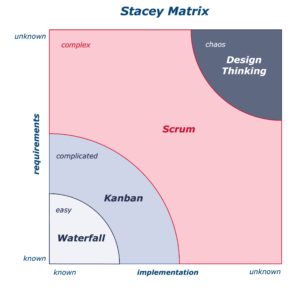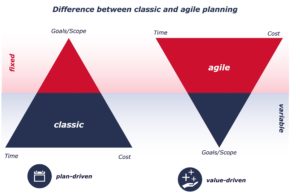The impact levels of agility are people, communication, leadership, organization, culture and technology

In an agile restructuring (“transformation”) of an organization, the six impact levels of agility must be observed and implemented accordingly.
The most important part of setting up an agile organization is the people. This initially includes the selection of suitable employees who, on the one hand, fit the intended position in the agile set-up professionally and, on the other hand, have a fundamental willingness to work in an agile manner. This “casting” requires a longer lead time, especially in order to carry out the necessary training. A hectic pace can easily lead to hasty decisions such as miscasts, which can disrupt cooperation within the agile teams, diminish acceptance of the new form of work, and revive old roles or behavioral patterns.
Effective communication is characterized by early action and transparency. Anyone reforming a company should take the staff’s fear of upheaval in their daily work seriously and address it before it causes passive resistance. A clear goal and roadmap will help gain the trust of the workforce. To anchor agile thinking and working in people’s minds, its fundamentals, structures, tasks and processes must be communicated comprehensively. Among other things, it must be clear that new role titles do not serve to relabel old positions, but arise from a reorientation in terms of content and methodology.
Leadership is also important in this context. Management must set an example of agile values. Managers should strengthen their employees’ sense of responsibility and encourage them to act on their own initiative. This requires managers to be willing to delegate decisions. Managers must undergo the transformation from classic supervisor to “servant leader.” This means a manager who serves the organization and other individuals in his or her actions.
In the context of an agile transformation, it makes sense to break up the organizational structure and set it up anew. Often, this involves setting up a matrix organizational structure with regard to products and/or services. In addition, some agile or hybrid organizations establish cross-divisional teams that are dedicated to special activities such as testing, for example. It is also advisable to flatten the corporate hierarchy. Teams should be reorganized to counteract the persistence of old structures.
A culture of trust and respect is to be created. Cultural change also includes the introduction of a positive culture of making mistakes and learning (“fail fast, fail often”). Those who are allowed to fail learn faster and deliver better results in the end.
Another factor is technology. The introduction of agility is often accompanied by digitization, such as the introduction of new hardware and software (e.g. Jira) or the automation of processes.








